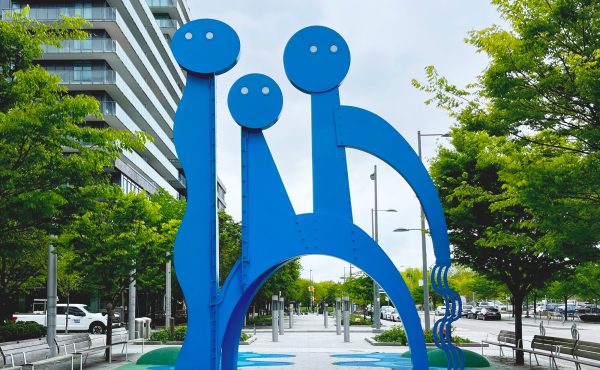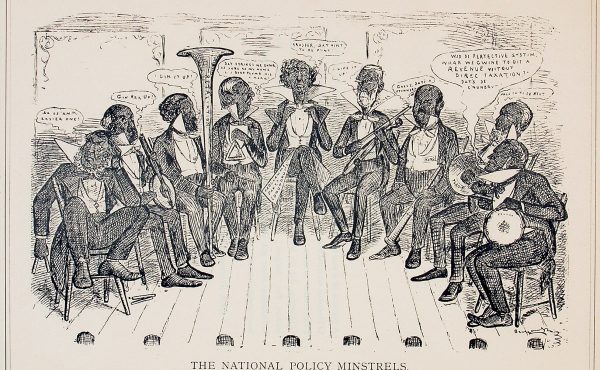
Starting on Thursday, pedestrians will be able to cross the intersection of Yonge and Dundas diagonally, without worrying about cars.
The City is ready to activate a “pedestrian priority phase” at this intersection. In addition to the regular east-west and north-south traffic phases, there will be a phase specifically for pedestrians to cross the intersection any which way they want. All the vehicle traffic signals will be red, and all the pedestrian signals will signal “walk” — including new signals facing diagonally across the intersection. The pedestrian priority phase will be 28 seconds out of a total 80-second cycle for the three traffic signal phases.
During the regular traffic phases, pedestrians will still be able to cross in the normal way, too. This is a change — and a huge improvement for pedestrians — from the way many of these systems work in other cities, where pedestrians can’t cross during the car traffic phases. It was made easier by the fact that cars are already not allowed to make any turns at this intersection. It’s a good decision by the city — it means the new phase is a clear benefit for pedestrians, rather than a trade-off with potentially longer wait times.
The city has announced it is taking a few measures to help with the transition to this unfamiliar new system, including providing some staff and police on hand initially to assist people with the change, making sure the phases are long enough to enable all pedestrians to clear the intersection, enhancing the Accessible Pedestrian Signals to assist the blind and visually impaired, and monitoring the intersection to determine whether any adjustments need to be made.
This initiative is a welcome recognition that pedestrians are a significant part of traffic, and should not be treated as just an afterthought. At this and a few other downtown intersections, probably the majority of people crossing the intersection are on foot, so it makes sense to provide extra time for them. As well, the sidewalk at some of the corners of these intersections are too narrow to cope with peak walking volumes (e.g. the north corners of Dundas and Yonge), which tends to push pedestrians onto the street, creating conflicts and possible danger with cars, as well as blocking the sidewalks for walkers who just want to pass through. The new system will, ideally, reduce this state of pedlock by passing pedestrians through the intersection more quickly.
The city is also considering a similar phase for other pedestrian-heavy downtown intersections: Yonge and Bloor Streets, Bay Street and Bloor Street West, and Bay Street and Dundas Street West. (The city started at Dundas and Yonge because Bloor is currently occupied with the ongoing streetscaping project). There was some initial concern about possible delays to the Dundas streetcar, but the TTC was apparently cooperative and agreed to the plan.
This initiative is part of a series of small steps the City decided to undertake to improve sustainable transportation in Toronto quickly in a concrete way while the city is still working on its somewhat delayed walking strategy, and Metrolinx is still working on its somewhat delayed regional transportation strategy.
These kinds of intersections are also often called “scramble” intersections, since pedestrians can go any way they want, or “Barnes Dance” after US traffic engineer Henry Barnes, who is credited with popularizing them to the US.
The new pedestrian priority phase at Yonge and Dundas will be officially launched by councillor Kyle Rae at 11:00 am on Thursday August 28.
photo by Sam Javanrouh




16 comments
These have been a long time in coming. I remember first encountering a pedestrian scramble intersection in, I think, Madison, Wisconsin, back in the 1980s. I’m glad to see Toronto finally catching up!
There have been conflicting messages in the media about whether pedestrians would still be able to cross with traffic during the general north-south and east-west traffic phases. The news that the city will continue to restrict turns and allow pedestrians to cross with traffic is most welcome.
The closest scramble intersection I know of is in downtown Guelph, but that is only a T-intersection, at St. George’s Square. I believe part of the purpose of this is that all the buses meet here at once every 20 or 30 minutes, so it makes transfers easier.
“Narrow sidewalks tend to push pedestrians onto the street, creating conflicts and possible danger with cars”
Not to mention conflicts with cyclists who are usually riding much closer to the curb than vehicles.
This sounds like a great opportunity for a flash mob or some other spontaneous group to get together and have some fun with the new intersection! Help show everyone else how it’s done.
Speaking of conflicts with cyclists, it will be interesting to see how they handle the diagonal phase. By law, I believe they’re supposed to wait at the light unless they dismount and walk their bike… but I suspect many will decide to ride through the throngs of pedestrians.
Sean: Or, conversely, limiting pedestrians to the scramble would reduce idling time in cars (and wasted gas/emissions) and improve the flow of traffic.
While I’m not opposed to this in the least…
I find it very hard to get excited about.
At the end of the day, the intersection and Yonge and Dundas don’t look any better; there’s no additional room for walkers or cyclists or to improve Dundas Streetcar ROW.
I worry that the paltry sum of money (probably still many thousands) that this cost may be used as an excuse for deferring other more important projects.
Before I moan about that Yonge Street Road narrowing we need (for wider sidewalks and 2 bike lanes)….
I’d settle for far more aggressive implementation of projects already proposed, planned, approved etc.
I’ll take the new scramble intersection; but please tell me there is more and better to come…. SOON.
If, as the article says, cars aren’t allowed to make any turns at the intersection anyway, how does limiting pedestrians to the scramble reduce idling time in cars? When the light is red, they cannot go — pedestrians might as well pass in front of them while cross traffic does.
I’ve heard there may be somewhat aggressive enforcement against bicycles riding through the ped phase.
Eric: Ah yes. Forgot about that. Consider the question then to be more in generality, and not specific to this intersection.
Great idea, Bob!
hmm…in 80 seconds?- how many push-ups? back-flips? kick-flips? how many times around that intersection? How about an 80 second rave!?
Every school year I regularly go through this intersection on my way to class at Ryerson.
The north-west corner of Yonge & Dundas is, by far, the most congested street corner I’ve ever encountered. It’s absolutely infuriating.
I find myself wanting to shove some people who completely block any kind of path to the subway entrance on the west end of the corner, apparently baffled by the concept of people needing to get around them. They simply mill about, aimlessly gawking at the bright lights and video screens, having a conversation with friends, while being directly in the way of an entire crowd of people making their way to, or coming from the subway entrance, leaving zero room for navigating around them. Aboslutely no consideration others, or for how tightly packed that corner is.
Is it possible to get pedestrian rage?
So is someone from Spacing be blogging from the site during the launch?
Not exactly live blogging from the site but something special is planned stay tuned.
Woo-hoo! Gonna dash out right now a try it! I’ll be the one doing the touchdown booty-shake.
Oh and this’ll make it easier to avoid those nutso evangelists that preach damnation into the back of your head while you’re stuck on the curb at the red light.
@William: Oh yeah. Except it’s much less dangerous since I don’t have a 6-ton vehicle to ram into people … maybe my purse to whack the back of your head 😛